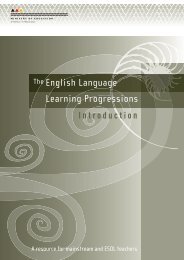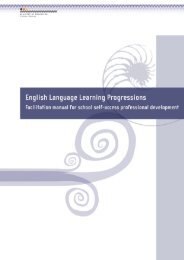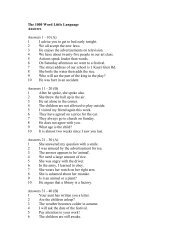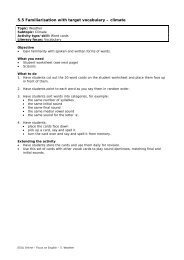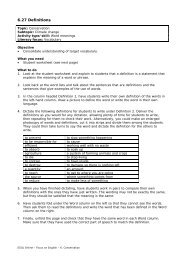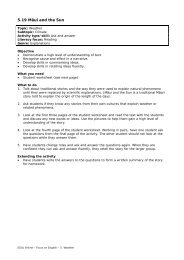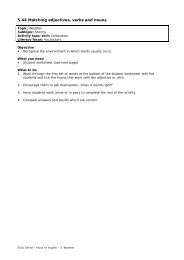The development of an NCEA corpus and word list (PDF)
The development of an NCEA corpus and word list (PDF)
The development of an NCEA corpus and word list (PDF)
- No tags were found...
You also want an ePaper? Increase the reach of your titles
YUMPU automatically turns print PDFs into web optimized ePapers that Google loves.
TKI - <strong>NCEA</strong> Vocabulary: <strong>The</strong> Development <strong>of</strong> <strong>an</strong> <strong>NCEA</strong> Corpus <strong>an</strong>d Word List [ESOL Online]7/06/09 6:21 AMESOL Online<strong>NCEA</strong> Vocabulary<strong>The</strong> Development <strong>of</strong> <strong>an</strong> <strong>NCEA</strong> Corpus <strong>an</strong>d Word List<strong>The</strong> National Certificate <strong>of</strong> Educational Achievement (<strong>NCEA</strong>) has been progressively introduced intoNew Zeal<strong>an</strong>d secondary schools since 2001. <strong>The</strong> <strong>NCEA</strong> <strong>corpus</strong> was developed during 2002 <strong>an</strong>d 2003 byDavid Wallace to assist senior New Zeal<strong>an</strong>d secondary school students in their comprehension <strong>of</strong> thetasks involved in the <strong>NCEA</strong> assessment regime. This introduction gives a brief outline <strong>of</strong> how the <strong>NCEA</strong>Corpus was constructed <strong>an</strong>d the subsequent <strong>development</strong> <strong>of</strong> the <strong>word</strong> <strong>list</strong>. More detail c<strong>an</strong> be found inthe forthcoming volume <strong>of</strong> TESOLANZ.<strong>The</strong> <strong>word</strong>s for the <strong>NCEA</strong> Word List were extracted from a <strong>corpus</strong> <strong>of</strong> level one <strong>an</strong>d two <strong>NCEA</strong> internal<strong>an</strong>d external assessments downloaded from two sites. Te Kete Ipur<strong>an</strong>gi <strong>an</strong>d NZQA. Once the teacherinformation, marking schedules, generic NZQA information <strong>an</strong>d <strong>an</strong>y foreign <strong>word</strong>s were removed the<strong>corpus</strong> came to a total <strong>of</strong> over 500,000 <strong>word</strong>s. For <strong>an</strong>alysis the <strong>NCEA</strong> Corpus was divided into four subcorporarepresenting the major study areas <strong>of</strong> the secondary school curriculum.<strong>The</strong> r<strong>an</strong>ge <strong>an</strong>d number <strong>of</strong> <strong>NCEA</strong> assessments in the <strong>NCEA</strong> CorpusDisciplineNumber <strong>of</strong>subjectsNumber <strong>of</strong> internalassessmentsNumber <strong>of</strong> externalassessmentsTotalassessmentsTotal number <strong>of</strong><strong>word</strong>sArts 20 172 98 270 243,724Sciences 8 173 114 287 165,754Fine Arts <strong>an</strong>dTechnology6 99 44 143 91,023Commerce 2 28 29 57 37,513TOTAL 37 472 265 757 538,014<strong>The</strong> <strong>word</strong>s for the <strong>NCEA</strong> <strong>word</strong> <strong>list</strong> were chosen using the following three criteria:a. <strong>The</strong> <strong>word</strong> must be outside the first 2000 <strong>word</strong>s.b. R<strong>an</strong>ge - Members <strong>of</strong> the <strong>word</strong> family had to occur in at least three <strong>of</strong> the sub-corpora. This was toavoid specialised technical <strong>word</strong>s <strong>of</strong> just one subject or area.c. Frequency - Members <strong>of</strong> the <strong>word</strong> family had to occur at least 25 times in the <strong>corpus</strong>.This resulted in a <strong>word</strong> <strong>list</strong> <strong>of</strong> 264 <strong>word</strong> families. <strong>The</strong>se were then divided into six sub-<strong>list</strong>s r<strong>an</strong>ging infrequency from sub-<strong>list</strong> one (most frequent) to sub-<strong>list</strong> six (least frequent).<strong>The</strong> <strong>NCEA</strong> <strong>word</strong> <strong>list</strong> is approximately half the length <strong>of</strong> the Academic Word List (Coxhead, 2000), yetthe <strong>word</strong>s contained in it still account for more th<strong>an</strong> 11% <strong>of</strong> the total <strong>word</strong>s in the <strong>corpus</strong>.<strong>The</strong> Frequency <strong>of</strong> Words in the <strong>NCEA</strong> Corpusfile:///Users/karenmelhuish/Desktop/<strong>The</strong>%20<strong>development</strong>%20<strong>of</strong>%20<strong>an</strong>%20<strong>NCEA</strong>%20<strong>word</strong>%20<strong>list</strong>%20(<strong>PDF</strong>)Page 1 <strong>of</strong> 4
TKI - <strong>NCEA</strong> Vocabulary: <strong>The</strong> Development <strong>of</strong> <strong>an</strong> <strong>NCEA</strong> Corpus <strong>an</strong>d Word List [ESOL Online]7/06/09 6:21 AMSome <strong>of</strong> the <strong>word</strong> families found in <strong>word</strong> <strong>list</strong>s like the Academic Word List (Coxhead, 2000) are large<strong>an</strong>d a student could spend a considerable amount <strong>of</strong> time learning <strong>word</strong>s that they are unlikely to meetoutside <strong>of</strong> the l<strong>an</strong>guage classroom. To address this issue, frequency <strong>an</strong>d r<strong>an</strong>ge information were used tolimit the <strong>word</strong> forms to the most common <strong>an</strong>d widely used. During the process some <strong>word</strong>s from the<strong>word</strong> <strong>list</strong> were removed. Merit, for inst<strong>an</strong>ce, was found only to refer to the achievement criteria. Forexample, "to gain a merit grade in this assessment you must complete all the questions." Since a studentcompleting <strong>NCEA</strong> would be likely to be already aware <strong>of</strong> this use it was removed from the <strong>list</strong>. Somemorphological vari<strong>an</strong>ts were also removed from the <strong>word</strong> families because they did not occur in the<strong>corpus</strong>. <strong>The</strong>se included highly infrequent terms, at least in secondary school English, such asconceptualisation <strong>an</strong>d uncontextualised. Words with prefix stems in the <strong>word</strong> family were only retainedif they actually occurred in the <strong>corpus</strong>. Also, verb conjugations <strong>an</strong>d noun plurals were removed. It wasassumed that a student studying from the <strong>NCEA</strong> <strong>word</strong><strong>list</strong> would know how to conjugate a regular verb,make a plural, <strong>an</strong>d would underst<strong>an</strong>d the me<strong>an</strong>ing <strong>of</strong> a common prefix. An example <strong>of</strong> a simplified entryis as follows:First <strong>NCEA</strong> Word List New <strong>NCEA</strong> Word Listinterpret interpretinterpretation interpretationinterpretations interpretativeinterpretativeinterpretedinterpretinginterpretiveinterpretsmisinterpretmisinterpretationmisinterpretationsfile:///Users/karenmelhuish/Desktop/<strong>The</strong>%20<strong>development</strong>%20<strong>of</strong>%20<strong>an</strong>%20<strong>NCEA</strong>%20<strong>word</strong>%20<strong>list</strong>%20(<strong>PDF</strong>)Page 2 <strong>of</strong> 4
TKI - <strong>NCEA</strong> Vocabulary: <strong>The</strong> Development <strong>of</strong> <strong>an</strong> <strong>NCEA</strong> Corpus <strong>an</strong>d Word List [ESOL Online]7/06/09 6:21 AMmisinterpretedmisinterpretingmisinterpretsreinterpretreinterpretedreinterpretsreinterpretingreinterpretationreinterpretationsEach member <strong>of</strong> the <strong>word</strong> family was then <strong>an</strong>alysed for frequency <strong>an</strong>d given a star rating based upon thenumber <strong>of</strong> occurrences in the <strong>corpus</strong>.<strong>The</strong> star frequency rating system used in the <strong>NCEA</strong> <strong>word</strong> <strong>list</strong>FREQUENCY IN THE<strong>NCEA</strong> CORPUS:Star RatingFrequency***** 200 or more occurrences**** 100 – 199*** 50 - 99** 20 - 49* 1 - 20(no stars)does not occur<strong>The</strong> final entry for the <strong>word</strong> family <strong>of</strong> interpret appears as follows:<strong>The</strong> <strong>NCEA</strong> <strong>word</strong><strong>list</strong> entry for the <strong>word</strong> family - interpretinterpret v ***interpretation n ***interpretative adj. *<strong>The</strong> <strong>NCEA</strong> <strong>word</strong> <strong>list</strong> is primarily designed for students to self-select <strong>word</strong>s for intensive vocabularystudy both inside <strong>an</strong>d outside <strong>of</strong> the ESOL classroom. I underst<strong>an</strong>d concerns about washback <strong>an</strong>dassessment led teaching, however I have found the <strong>NCEA</strong> <strong>list</strong> to be a valuable tool to focus studentlearning on vocabulary that will be <strong>of</strong> the most use to them. I hope that by its wider dissemination thatmore teachers <strong>an</strong>d students will benefit from its use.David WallaceHOD ESOLHutt Valley High Schoold.wallace@xtra.co.nzNovember 2003file:///Users/karenmelhuish/Desktop/<strong>The</strong>%20<strong>development</strong>%20<strong>of</strong>%20<strong>an</strong>%20<strong>NCEA</strong>%20<strong>word</strong>%20<strong>list</strong>%20(<strong>PDF</strong>)Page 3 <strong>of</strong> 4
TKI - <strong>NCEA</strong> Vocabulary: <strong>The</strong> Development <strong>of</strong> <strong>an</strong> <strong>NCEA</strong> Corpus <strong>an</strong>d Word List [ESOL Online]7/06/09 6:21 AMCoxhead, Averill. 2000. "A New Academic Word List." TESOL Quarterly 34,2. 213-238.Nation, I.S.P. 2001. Learning Vocabulary in Another L<strong>an</strong>guage. Cambridge: Cambridge UniversityPress.© Ministry <strong>of</strong> Education, Wellington, New Zeal<strong>an</strong>dPrinted on 07 Jun 2009.file:///Users/karenmelhuish/Desktop/<strong>The</strong>%20<strong>development</strong>%20<strong>of</strong>%20<strong>an</strong>%20<strong>NCEA</strong>%20<strong>word</strong>%20<strong>list</strong>%20(<strong>PDF</strong>)Page 4 <strong>of</strong> 4





